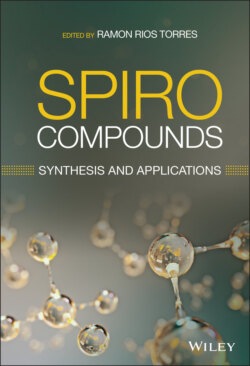Читать книгу Spiro Compounds - Группа авторов - Страница 18
2.6 Conclusions
ОглавлениеIn this chapter, a number of useful applications of spirocycles in medicinal chemistry and their impacts in drug discovery were highlighted. The introduction of spirocycles has proven valuable for optimizing key parameters such as conformational freedom/restriction, lipophilicity, solubility, basicity, and metabolic stability, in addition to opportunities in exploring novel chemical and IP space. As mentioned, the synthetic challenge associated with spirocyclic compounds along with the wider range of chemical transformations of historical building blocks such as reactive arenes have been major contributors to their lower occurrence in the drug discovery patent literature and in commercial small‐molecule screening libraries compared with non‐spirocyclic compounds. Controlling the stereochemistry of the spirocycle also adds to the challenge, and will be discussed in the subsequent chapters of this book. This last point also perhaps provides an explanation why the majority of synthetic spirocyclic compounds reported in the literature contain only one spirocycle. It is also worth mentioning that sp2‐rich systems also present some indubitable advantages when it comes to screening technologies (e.g. fragments), such as the ability to monitor their behavior (e.g. binding) in fluorescence‐based assays and ligand‐observed NMR experiments under water suppression conditions. The lack of suitable fluorophore or 1H chemical shifts in sub‐aromatic regions can make spirocyclic systems unsuitable in a number of biophysical assays if sp2 functionalities are not present elsewhere in the molecule. Additionally, despite the mounting evidence highlighting the potential of spirocycles for enhancing the metabolic stability of a wide range of compounds, examples of studies on their metabolites [61] are less common and much remains to be done to evaluate the wider stability landscape of individual spirocyclic classes in vitro and in full organisms. A systematic assessment of the molecular mechanisms and pathways underlying their metabolic activation in a context‐dependent manner will be paramount for the design of next‐generation spirocyclic structures with optimal stability. Nevertheless, the advances in chemical transformations and diversity‐oriented synthesis approaches [62–67] in the last two decades have changed the landscape. As a result, spirocycles have now made their way toward screening compound libraries and an ever‐increasing number of novel spirocyclic building blocks are now commercially available (Figure 2.11). Many institutions and commercial vendors have incorporated spirocyclic lead‐like compounds and fragments in their historical libraries, expanding the scope of available scaffolds for structure‐based drug design and novel IP generation. Four, five, and six‐membered rings containing spirocycles have historically received most attention for structure‐based drug design. This is in great part due to their inherent chemical stability compared with three‐membered rings, low conformational freedom compared with larger ring systems, hence greater rigidity providing highly directional vectors for derivatization and efficient receptor targeting. A recent review by Carreira and Fessard highlighted the potential of spirocycles for generating new IP in medicinal chemistry and beyond [48]. Overall, while the potential of spirocycles in medicinal chemistry is still to be fully exploited, the steadily expanding scope of synthetic methods, bioactive leads, and associated biological data promises to unlock a wide range of novel molecular entities and pharmacologies, with much needed benefits to patients lurking around the corner.
Figure 2.11 Representative examples of (a) multifunctional spiro building blocks and (b) lead compounds for screening that are currently available from commercial vendors.
